Blogs & Articles: Another History of Craig Wright Fraud And Deception: The Bitcoin Supercomputer Saga 🔗 17 weeks ago

- Category: Blogs & Articles | MyLegacyKit on Medium
- Author(s): MyLegacyKit
- Published: 29th December 2023 15:24
Unraveling the umpteenth Potemkin Village of our favorite Satoshi Nakamoto cosplayer
 Craig Wright once claimed — in November 2014 — to own up to 5 Bitcoin supercomputers. Source: Quora
Craig Wright once claimed — in November 2014 — to own up to 5 Bitcoin supercomputers. Source: Quora
Written by Arthur van Pelt
ABOUT EDITS AND UPDATES to this article: as more material may become available after the publication of this article, it could have edits and updates every now and then. In that sense, this article can be considered a work in progress, to become a reference piece for years to come.
“In the realm of cryptocurrencies and computer technology, Craig Wright emerged in 2013 as a controversial figure with audacious, often provably false claims and questionable if not fraudulent business dealings. One of his most infamous assertions involved the possession of no less than five supercomputers reportedly dedicated to Bitcoin mining and research. These claims, however, turned out to be a fabrication, leading to a protracted legal and financial battle between Wright and the Australian Taxation Office (ATO).” — Bard, Google’s online Artificial Intelligence tool when asked about Craig’s Bitcoin supercomputers in December 2023
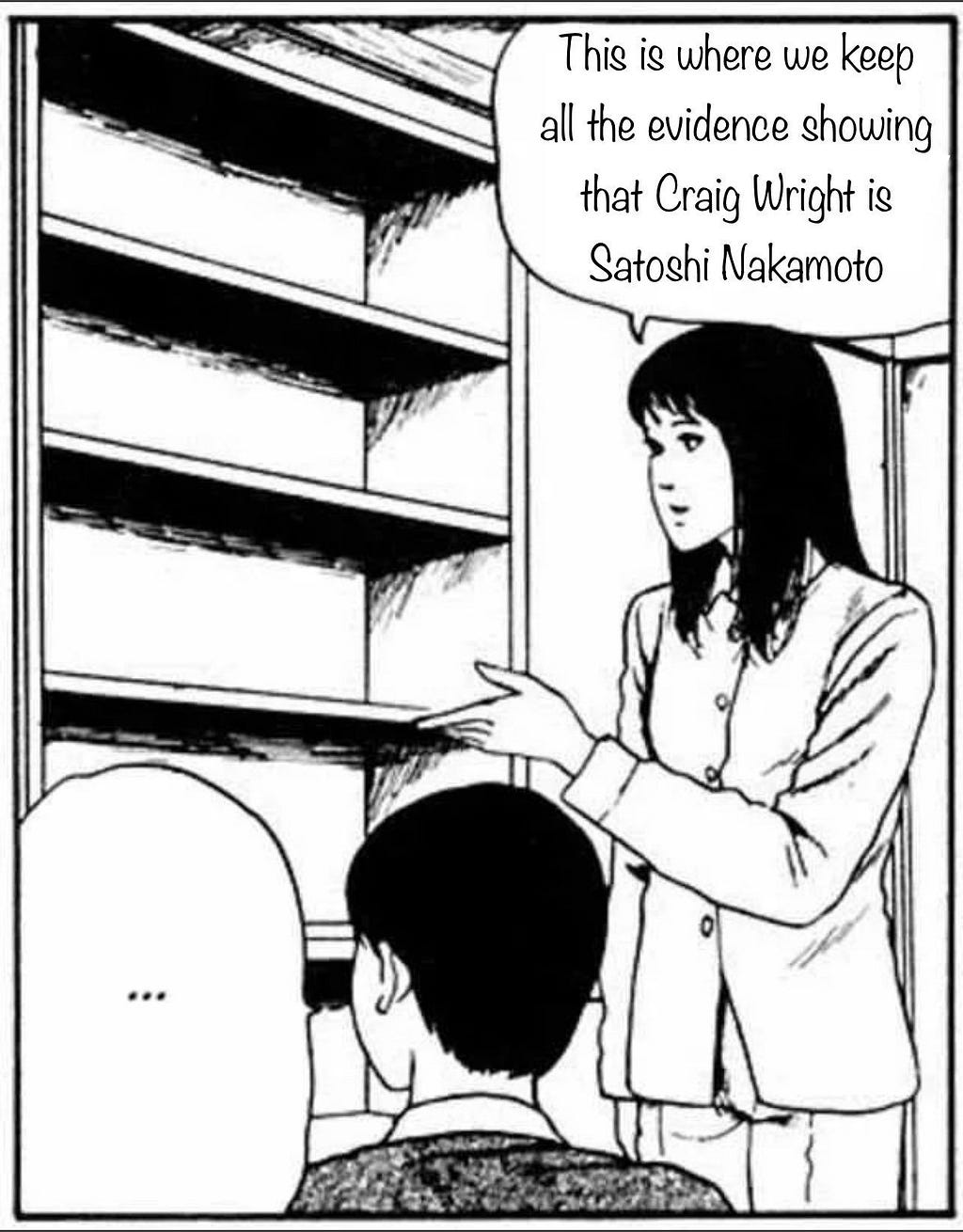 Source: Twitter (Tim Tayshun)
Source: Twitter (Tim Tayshun)
Those who read our (CryptoDevil and the undersigned) “Faketoshi, The Early Years” series that we run in August 2021 to October 2021 know about Craig Wright’s efforts to defraud the Australian Taxation Office in the 2013–2015 era with false GST and income tax refund claims and fraudulent R&D tax rebate filings.
Intertwined in this Australian tax fraud was a deceptive scheme with Bitcoin supercomputers. Many bits and pieces have been exposed and explained in the Early Years series, but the story of Craig Wright’s fake Bitcoin supercomputers has never been told before in detail in one comprehensive overview.
Until today.
The Prelude
To understand the full picture of the Craig Wright Bitcoin supercomputers saga, we go back to late 2008. Craig Wright was sacked from BDO, as he explained in January 2019 to Modern Consensus.
“Ten years ago was also the beginning of the great recession, which I’ve argued drastically shaped bitcoin.
Yes and luckily 10 years ago, I was given a golden handshake from BDO.
Oh wait. You mean you were laid off due to the recession? And that’s why you had time for all of this Bitcoin stuff?
In Sydney I got handed the golden handshake. They gave me the redundancy check. They said if you want to take money and not come back, have some money and go away. It was fortuitous. A couple weeks before that I was being a bum and I had two spare weeks to try things. My understanding is that this [the first Bitcoin transaction] was the start of the week. It was a weekday. In 2008, I would have been off working in the city and wouldn’t have had time to do anything. If it hadn’t have happened I probably would have quit anyway. So having them hand me a lot of extra cash was quite. I ran the IT audit. I ran digital forensics. I did CATS — computer aided audit technology. Audit firms everywhere started panicking. We were losing auditors in the recession.”
 Source: CourtListener
Source: CourtListener
The Companies 2009–2013
2009: The foundation is being laid for the upcoming Bitcoin scams.
Not that Craig Wright had any clue yet at this point in time of the role that Bitcoin would go play in his life four years later, of course, because in the 2007 — 2011 era Craig had no idea that Bitcoin even existed, let alone that the real Satoshi Nakamoto had just released Bitcoin in the wild in January of 2009.
Straight after being sacked from BDO in December 2008 with this “golden handshake” or “a lot of extra cash” of AU$10,938.00 (around US$7,150.00), Craig Wright incorporated two Australian companies.
- Information Defense Pty Ltd (January 29, 2009)
- Integyrs Pty Ltd (May 11, 2009)
These two companies were straightaway used by Craig Wright for shady tax business, it appears. Because in one of the many Australian Taxation Office (ATO) reports that we learned about in the Kleiman v Wright lawsuit — running from February 2018 to December 2021 — we find the following quote.
We learn a few interesting tidbits about three of the companies that Craig incorporated so far, being Ridges Estate (raised October 23, 2001 but not relevant for this Bitcoin supercomputer story), Information Defense and Integyrs.
“many where the ATO has disallowed R&D claims and imposed penalties”
Penalties are only given to naughty boys, right?
 Source: CourtListener
Source: CourtListener
This ATO report was filed in January 2022, shortly after the Kleiman v Wright trial in November/December 2021 concluded with a December 7, 2021 ruling by the trial Jury that defendant Craig Wright should pay $100,000,000 to plaintiff W&K (basically Ira Kleiman) for ‘Conversion’.
Notably, visible at footnote 6, there’s a gap between 2004 and 2008. This was the period that Craig Wright was employed by BDO in Australia and appears to have largely abandoned his R&D claims scheme, which he would pick up again after he left BDO in December 2008. More about that later.
2011: Craig Wright incorporates three more companies.
- Cloudcroft Pty Ltd (March 3, 2011)
- Panopticrypt Pty Ltd (June 20, 2011)
- Strasan Pty Ltd (July 21, 2011)
— renamed to C01n Pty Ltd (February 14, 2014)
Cloudcroft will become the vehicle where Craig Wright is going to put his Bitcoin supercomputers in later years.
April 2013
Let’s move forward to April 2013, a truly pivotal month in Craig Wright’s Bitcoin fraud career. No less than three notable events happened in the second half of April 2013. Firstly, Craig buys his first Bitcoin on Mt Gox, secondly, his ‘friend’ Dave Kleiman passes away, and thirdly he incorporates the Coin-Exch Pty Ltd company. Coin-Exch will become a member of the Hotwire Group.
August 26, 2013: Craig incorporates another four companies in Australia.
- Pholus Pty Ltd
- Denariuz Pty Ltd
- Zuhl Pty Ltd
- The Trustee for the Wright Family Trust
By now, the foundation has been laid for the Hotwire Group, two handfuls of companies that Craig Wright will use in an attempt to defraud AusIndustry and ATO for millions of Australian dollars in multiple types of tax refund and tax rebate claims for paper only projects and — activities, and faked buying & selling of diverse assets that he tried to give credibility with bookkeeping fraud.
For this article we only concentrate on the Bitcoin supercomputers.
September 15, 2013: Craig announces the Hotwire Group on his blog.
 Source: Craig Wright’s blog
Source: Craig Wright’s blog
With several hints like “Fifteen years of planning;” (apparently starting 1998), “Four years of development;” (apparently starting 2009: note that this appears to be a somewhat crippled link to Satoshi Nakamoto, as Satoshi started development of Bitcoin in 2007, while Craig indeed incorporated Information Defense in 2009 as the reader might remember, a company that Craig apparently incorporated in the Hotwire Group at this point in time) and “In the next nine months, secrets will start to come out.”, Craig is apparently slowly preparing the world for his Satoshi Nakamoto cosplay.
However, we will learn that the world, to Craig’s frustration, didn’t pay attention too much to this cosplay for at least two years from here…
The Bitcoin Supercomputers
September 25, 2013: Craig’s first Bitcoin supercomputer “Sukuriputo Okane” enters the scene
The first mention of a Bitcoin related supercomputer called Sukuriputo Okane (its name is very likely inspired by the Bitcoin inventor’s pseudonym Satoshi Nakamoto) is in a September 2013 email. That email can be found in a June 3, 2019 post on Craig Wright’s blog. At first glance, it’s an impressively smart looking email from a very bright Bitcoin architect-level developer.
But is Craig Wright even such person?
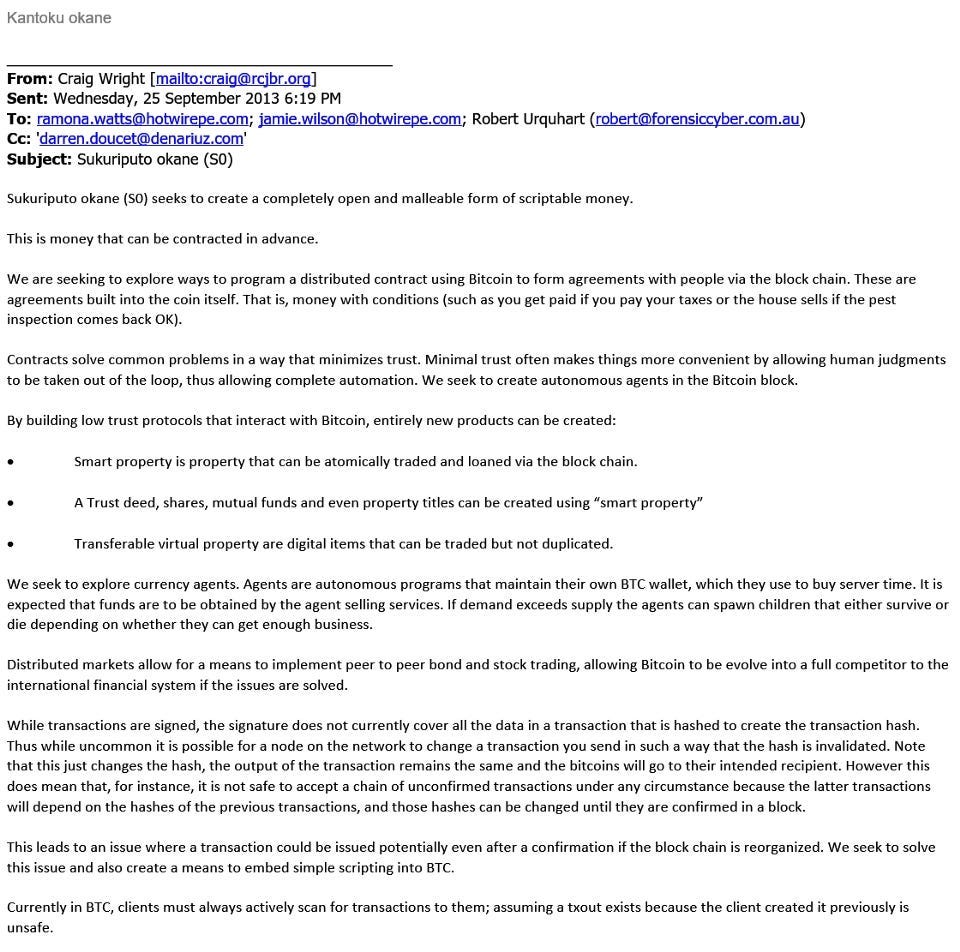
No, of course not. He never was, and he never will be a very bright Bitcoin architect-level developer. Because at second glance, one finds out that the meat of this email is simply copied from the Bitcoin Wiki. For example, some of the text is taken — both in paraphrase and verbatim form — from the Bitcoin Wiki Contract page, set up in 2012 by Mike Hearn and others.
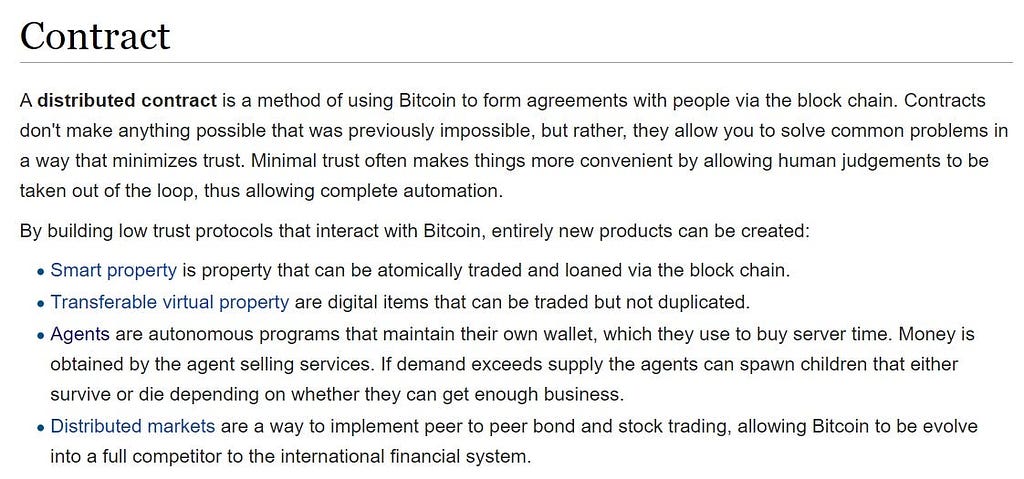 You will find basically this whole text mixed in Craig’s email
You will find basically this whole text mixed in Craig’s email
This is, plain and simple, plagiarism, of which Craig once, in June 2008, said “Plagiarism is more serious than most people think. It is a criminal breach of both the copyright act and is also a criminal fraud.”in the comments to his blog article “Tisk, tisk, tisk…” (scroll down a little for the comments section).
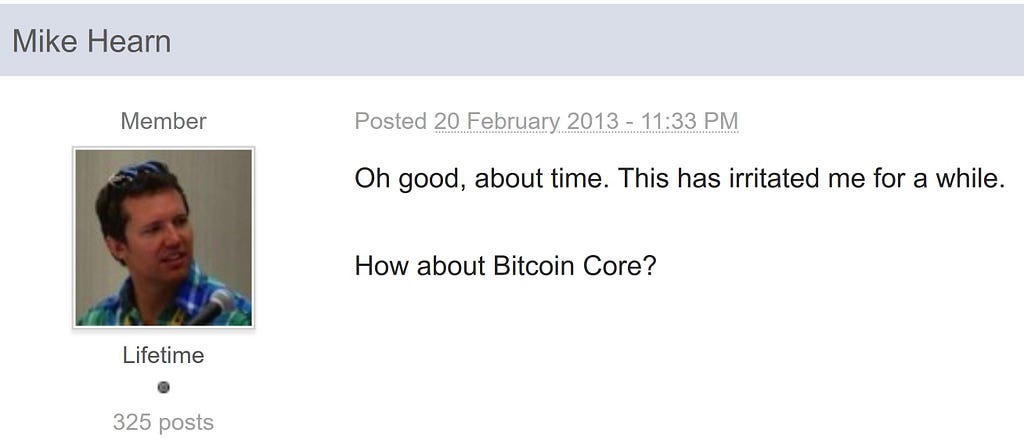 Mike Hearn on February 20, 2013 when asked by Gavin Andresen: “New name for Bitcoin-Qt / bitcoind ?” Source: WayBack Machine
Mike Hearn on February 20, 2013 when asked by Gavin Andresen: “New name for Bitcoin-Qt / bitcoind ?” Source: WayBack Machine
October 7, 2013:“Sukuriputo Okane” registered with AusIndustry
In October 2013 we find this first of several Bitcoin supercomputer projects that Craig Wright set up to scam the Australian government in an ATO report.
“The project is described as a software library for financial cryptography including a prototype server and high-level client API able to process Bitcoin transactions and markets.”
The Australian Taxation Office (ATO) however was quick to find out that “much of the application is taken from internet sources, without acknowledgement” and that the examples of the R&D activities were also “taken, unacknowledged, from an internet source”.
The reader only needs to scroll back to September 25, 2013 to know what ATO is talking about.
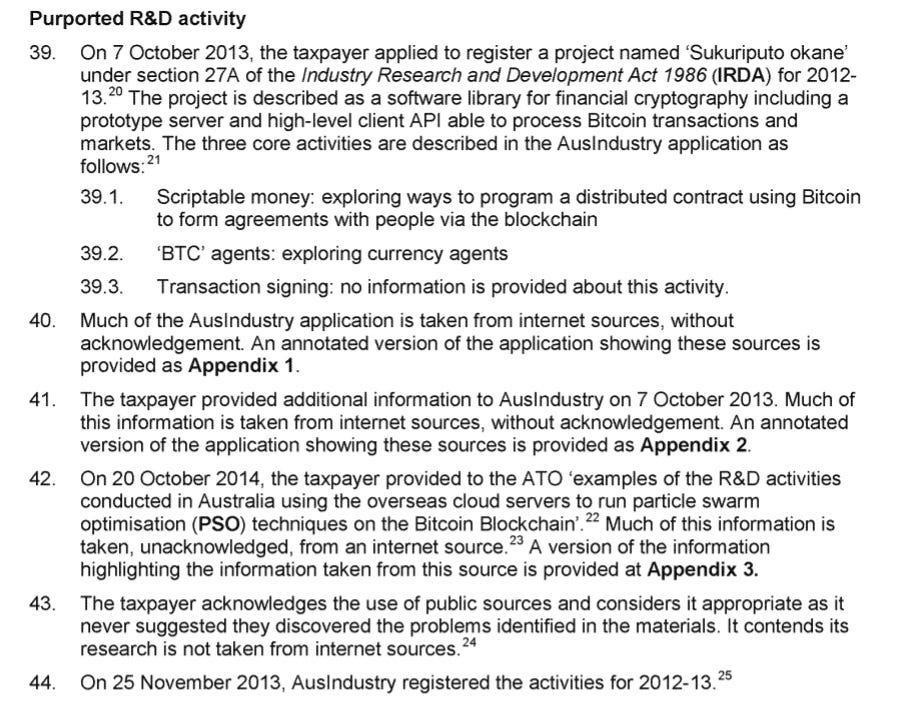 Source: CourtListener
Source: CourtListener
And these are signature moves from Craig Wright again, as we will see this type of plagiarism, literally copy-pasting from internet sources, is going through Craig’s fraud career as a fine red thread. And would the Bitcoin supercomputer disaster stop here? Don’t count on it!
November 2013: The two NSW Supreme Court claims
In the tax fraud mix of Craig Wright are also two fraudulently obtained NSW Supreme Court claims for a total amount of almost AU$57 million in November 2013 (as described in “Craig Wright Ordered to Pay $100 Million in Kleiman v Wright Lawsuit”), and this “value” is received by Craig in the form of Bitcoin IP that he, as he claims, years earlier put in W&K for a meagre $5,000. This Bitcoin IP now also shuffled back and forth between his companies, and is used in combination with the Bitcoin supercomputers.
December 6, 2013: And another Bitcoin supercomputer enters the scene!
Meet C01N, the second Bitcoin supercomputer that Craig Wright claims to have had in the early years. He actually claimed C01N was already in use in September 2012!
It appears ATO was again not very impressed with this machine. Nor with Craig’s performance in handling the audit. From one of the ATO reports:
 Source: CourtListener
Source: CourtListener
February 10, 2014: Hotwire starts tweeting
This is the first of only four tweets that Hotwire, who opened a Twitter account in February 2014 so only days before their first tweet, ever produced. We notice roaring marketing buzz about “Worlds First Bitcoin Bank”, but knowing it’s a paper-only scheme to defraud ATO for millions… A sick tweet in hindsight.
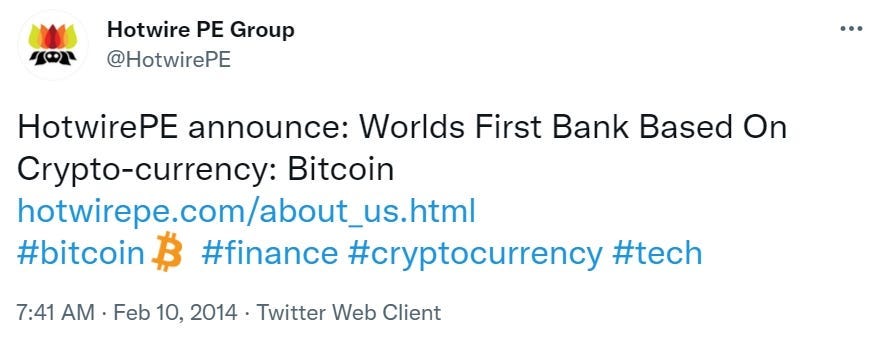 Source: Twitter
Source: Twitter
Now let’s have a look at the Hotwire website, on Wayback Machine as Craig Wright deleted all online presence from this era during his flight to London in December 2015 around the ATO raids on his premises. We notice several of the companies (but not the full ten that he announced on his blog in September 2013 though) that had recently been incorporated by Craig, and at closer look: Craig summarizes his experience up to 2014, almost exclusively in the fields of Information Technology and Cybersecurity, Research and Forensics. There is notably no link or overlap whatsoever with the cypherpunk era designing, coding and launching of Bitcoin by Satoshi Nakamoto. But that’s not a surprise, of course.
Also note that Cloudcroft, the company where the alleged Bitcoin supercomputers are supposed to be on the asset list, is not mentioned, for reasons currently unknown.
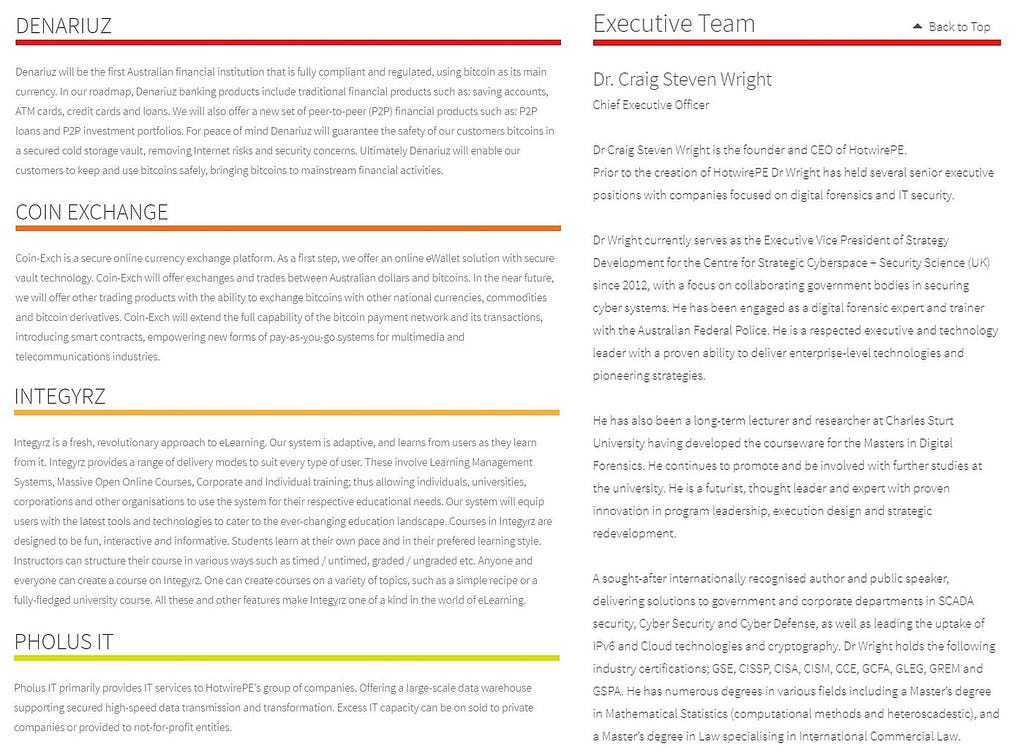 Source: WayBack Machine
Source: WayBack Machine
April 28, 2014: And oops, Hotwire Group already bankrupt.
“And that is the mess we are in.” — Craig Wright, 3 days earlier in an email to Ira Kleiman.
And indeed, it’s a mess for Craig Wright. As within 3 months after launch, Craig’s Potemkin Village called Hotwire is no longer able to stay afloat. On this day, McGrath & Nicol are being appointed as Administrators to handle the debt owed to all Hotwire creditors, except for “Craig Wright, Ramona Watts and Panopticrypt in the sum of circa $1,437,898 whose claims will remain, only to be enforceable against the company in the event that the company has available assets (after payment of all other creditors in full)”.
On May 14, 2014 McGrath & Nicol released a report which is providing a revealing peek in how Craig Wright’s Hotwire business dealings were almost 100% dependant on tax returns, and how the bankruptcy was due to tax returns that never came.
The following snippet is taken from Nik Cubrilovic’s blog article “Craig Wright is not Satoshi Nakamoto”, who wrote this must read monster of an article on May 2, 2016.
“The Company’s main activity was the acquisition of various e-learning and e-payment software and undertaking research and development work in respect of this software and for software owned by related entities. […] The Directors have advised that $30 million was subscribed to by the shareholders in paid up capital and this was injected via Bitcoins. […] The Company applied its equity as follows:
– $29 million to acquire software from the Wright Family Trust (“the Trust”); and
– $1 million to fund day to day trading activities.”
“What Wright did was establish a company for the purpose of carrying out research and development on e-learning software it had acquired from Wrights own trust. Wright would inject $30 million in Bitcoin to fund the company, $29 million of which would be paid to Wright’s trust to acquire the software and $1 million of which would fund operational costs — including an office in Sydney and 40 employees.
The purpose for the structure and why someone could commit fraud in this way becomes clear in the next action the company takes:
Further to incurring a range of expenses, the Company lodged its GST return for the September 2013 quarter, claiming a GST refund of $3.1 million (“the GST refund”). After various discussions and correspondence, the ATO issued a notice to the Company on 20 January 2014 notifying that it intended to withhold the refund pending further verification of transactions and the treatment of Bitcoin.
The sales tax (GST) component of the $29 million invested by Wright into the company was eligible for a refund. Thus by shuffling around some Bitcoin between entities you control yourself, it is possible to trigger a sales tax refund (in real cash).” — Nik Cubrilovic (on his own blog)
“Wright’s primary Modus Operandi these past few years, prior to fleeing Australia, was using various entities to create real-dollar tax refunds out of non-existent Bitcoins. I’m surprised it worked for as long as it did.
These cases do explain his motive for why he presented himself as Satoshi Nakamoto.” — Nik Cubrilovic (on Reddit)
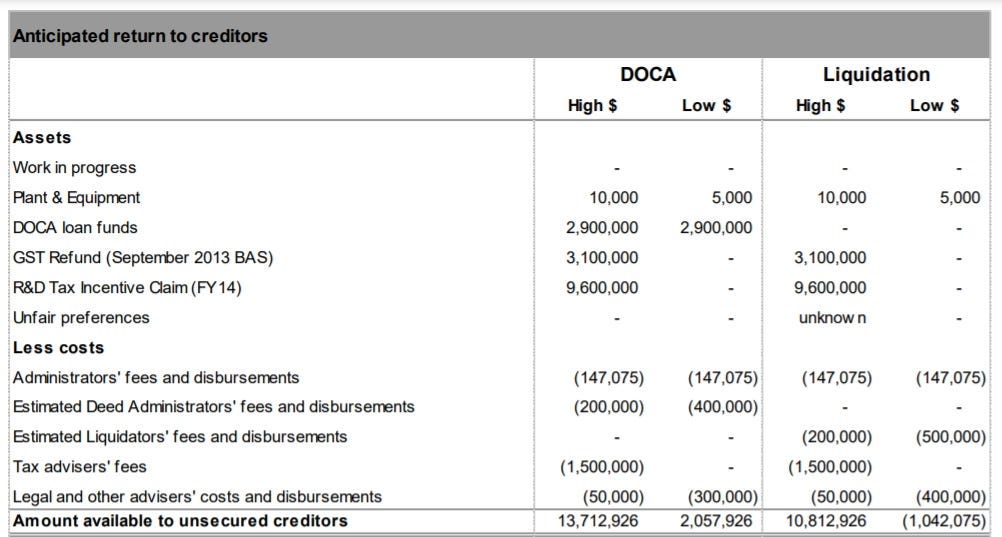 Image from the McGrath & Nicol report
Image from the McGrath & Nicol report
To add to Nik’s analysis, this bookkeeping trick of Craig Wright of “creating real-dollar tax refunds out of non-existent Bitcoins” is supported by a “Bitcoin mining since 2009 — stash” and by handfuls of Bitcoin public addresses with large holdings that Craig claimed to own and that were “assigned rights to”, according Craig. In reality, however, Craig Wright had no mining stash as he had never mined Bitcoin in the 2009/2010 era (nor later), and neither did he own any bitcoin on any whale address. Those whale addresses were actually randomly taken from the Bitcoin rich list, and from there Craig had pulled the rest of the stories from his ass, sorry, rich fantasy I mean.
Then Craig repeats this bookkeeping trick with Bitcoin loans and Bitcoin rights assignments within and between all his companies, leading to several more false R&D tax rebate and other tax return claims, and often numbering in the multiple millions in Australian dollars.
In the McGrath & Nicol image above we can find that Craig’s attempt to defraud ATO with Hotwire was about at least a GST Refund of $3,100,000 and a R&D Tax Incentive Claim of $9,600,000 (totalling $12,700,000).
Let’s take another screenshot from that report.
 “we understand Dr Wright had a significant exposure”
“we understand Dr Wright had a significant exposure”
As the reader can see above, here’s Craig indirectly claiming that he had a ‘significant exposure’ on Mt Gox which he lost in its collapse a few months earlier, and that is why he can no longer help with funding Hotwire. Mind you, that ‘significant exposure’ of a little over 14.5 BTC (or some $8,000 in USD) that he owned on the Mt Gox exchange at the moment of its collapse could have saved Hotwire for, like, half a day?
But also remember this, none of his prior ‘funding’ actually involved cash, outside of what he had conned from the Australian taxpayers.
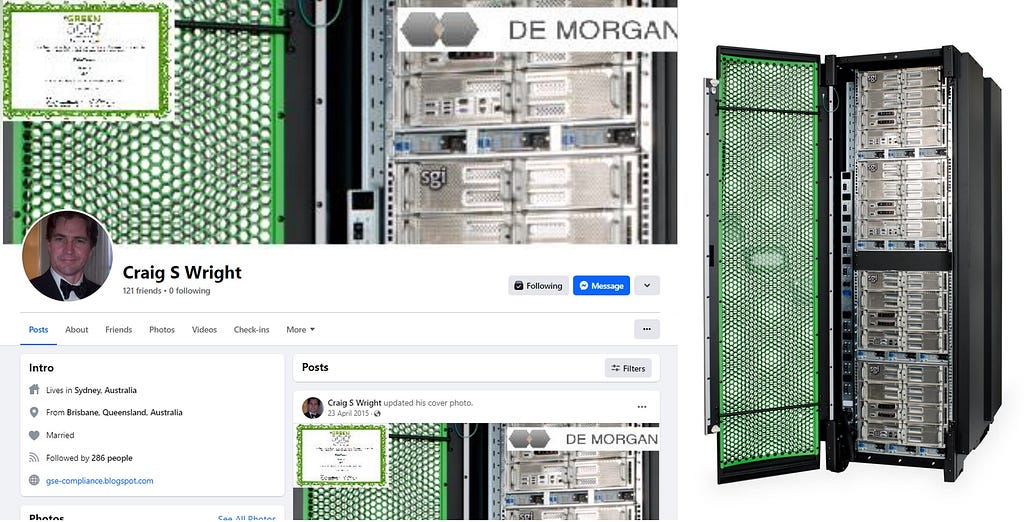 Craig Wright’s Facebook profile (left) contained an SGI image (note the ‘sgi’ watermark) that he found in an article about supercomputers on The Register website (right).
Craig Wright’s Facebook profile (left) contained an SGI image (note the ‘sgi’ watermark) that he found in an article about supercomputers on The Register website (right).
October 31, 2014: And here’s Bitcoin supercomputer number three!
Let’s round out the year with Craig pretending to own yet another Bitcoin supercomputer. This is where ‘Tulip Trading’ joins ‘C01N’ in Craig’s Potemkin Village as not just the ATO, but supercomputer-supplier SGI, themselves, go on to prove.
For the whole of 2014, Craig didn’t post much on his blog, with two exceptions, both times about his Bitcoin supercomputers. This is one of them. Those who know how this Bitcoin supercomputers story is going to end, can start ROFL-ing about “1160 Xeon cores” and “both systems in the top 500” now.
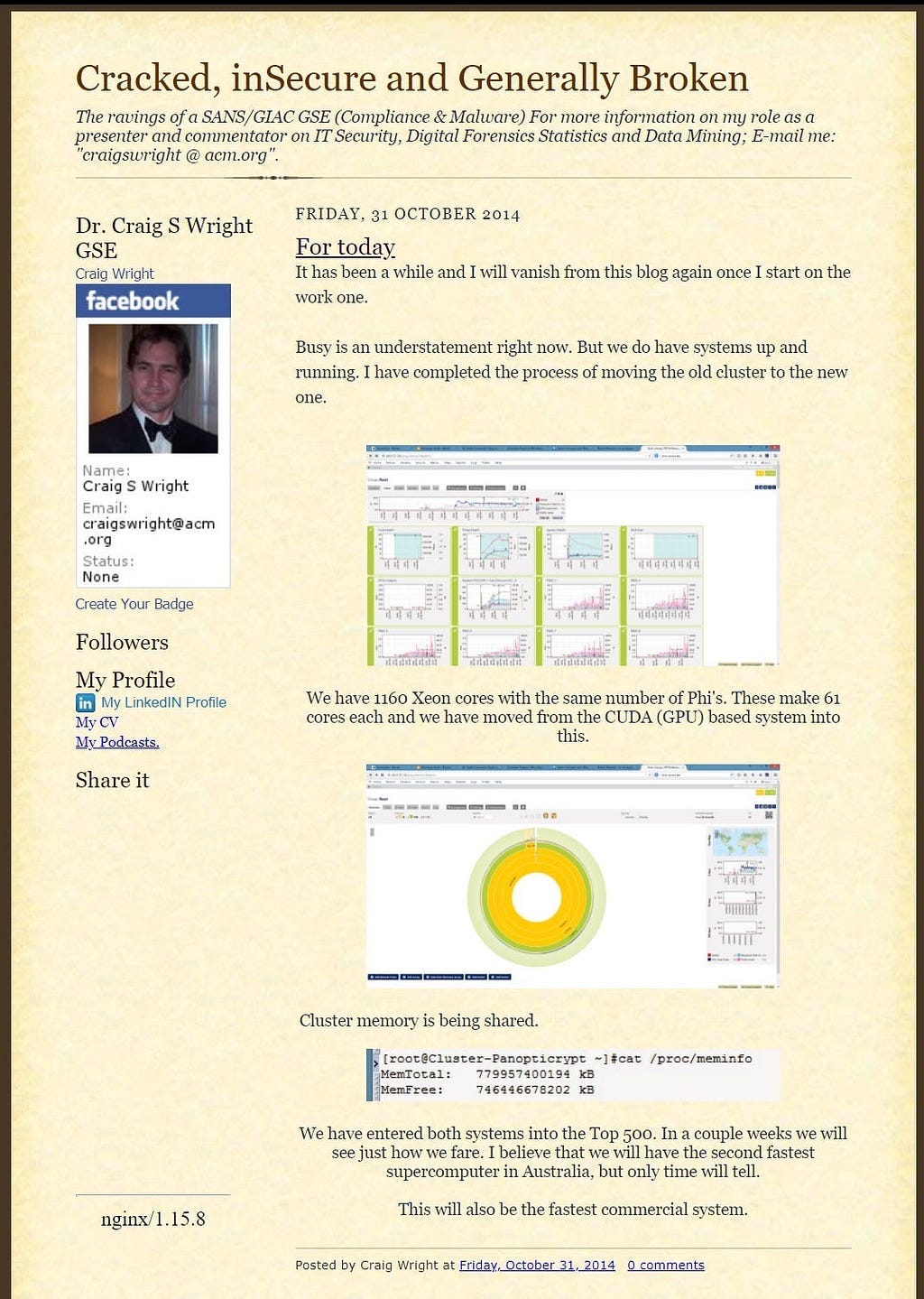 Source: Craig’s blog on WayBack Machine
Source: Craig’s blog on WayBack Machine
Craig also provides some more information on the Cloudcroft website, in a blog article called “Introducing Cloudcroft” a day earlier:
“Now, many of you will probably think mining Bitcoin, if we are going to be running a large supercomputer, well, would you want to mine Bitcoin? This is our second one, and back in the day, you could have mined a lot of Bitcoin on the previous generation that we were running, it was mainly graphics cards so GPU based and at the time that would have been comparable to many of the other people out there. Now, however, it is a little bit different, and even then we weren’t actually mining, what we were doing, is a whole lot of PSOs, this is optimising code, so evolutionary programming etc. One of the things we are now doing, is we are finding that even if we wanted to mine, the Xenon PHIs aren’t terribly good as miners, but they are really great at running lot of those really, really, highly parallel code. It takes a lot of tuning and a lot of effort to get it right, but once you do, the results are wonderful. I mean, they are incredible, the speed of these machines, the access to the amount of ram that we get, when we are running up… I think we are running 770 Peta Bytes of Ram at the moment on the cluster. It’s quite amazing when you consider just how much there is.” — Craig Wright
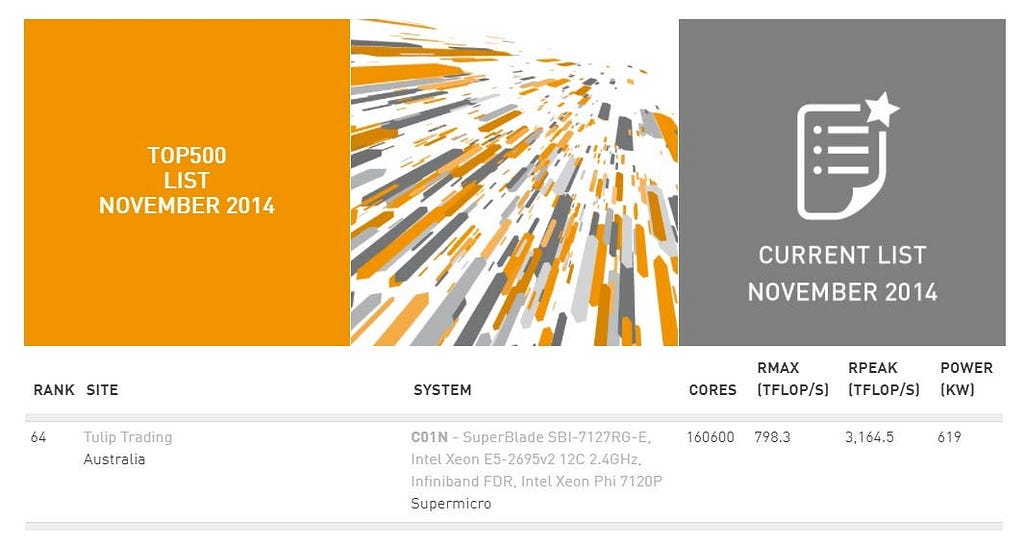 Source: Top500 website on WayBack Machine
Source: Top500 website on WayBack Machine
November 2014: Craig managed to get the Tulip Trading/C01N supercomputer in the Top500 list on #64.
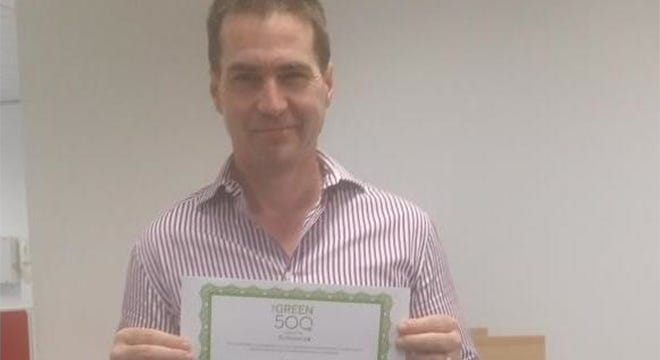 Craig Wright, Macquarie Park lab, December 2014
Craig Wright, Macquarie Park lab, December 2014
Because what better way is there for Craig to absolutely, unequivocally prove to the terribly persistent doubting-Thomas which is the ATO, who simply won’t let him be at peace with the many millions of dollars he has scammed in a multitude of fraudulent R&D and GST rebates, than showing them his Bitcoin supercomputer is actually listed in the esteemed ‘Top 500’ list, right?
Only, the fact of the matter is that the authors of the ‘Top500’ list relied solely on Craig’s own claims as to the existence of his supposed Bitcoin supercomputer.
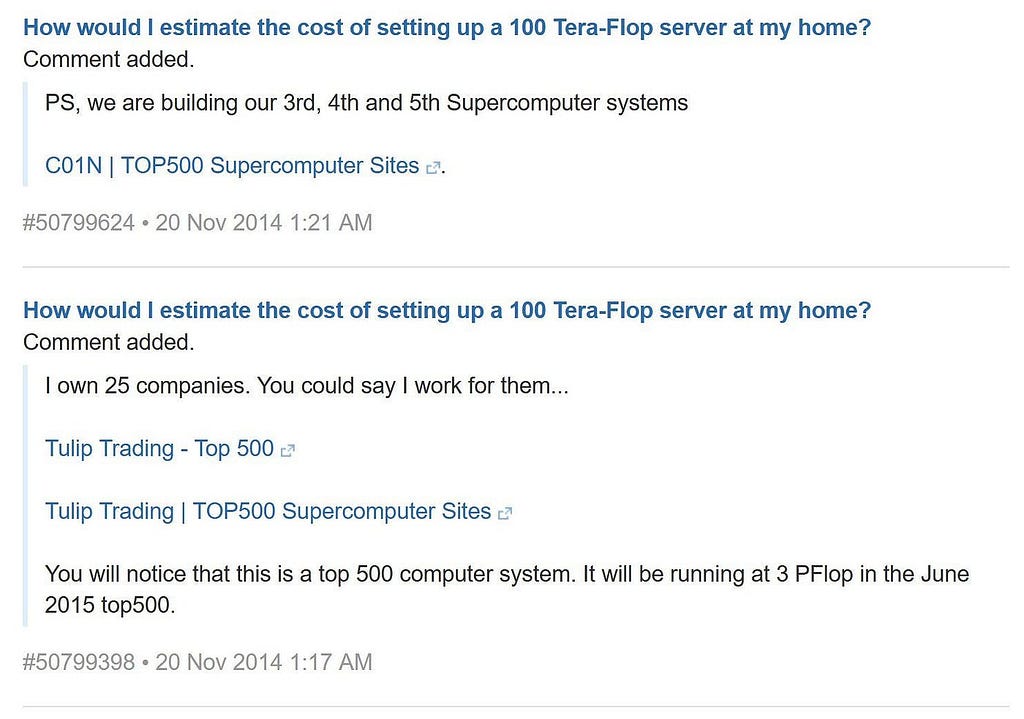 On Quora Craig Wright mentioned no less than 5 supercomputers on November 20, 2014.
On Quora Craig Wright mentioned no less than 5 supercomputers on November 20, 2014.
The ATO go on to roundly excoriate him over these faked machines, but we’ll let the supposed supplier, SGI, have the last word, as per their comment when asked by ZDNet in December 2015:
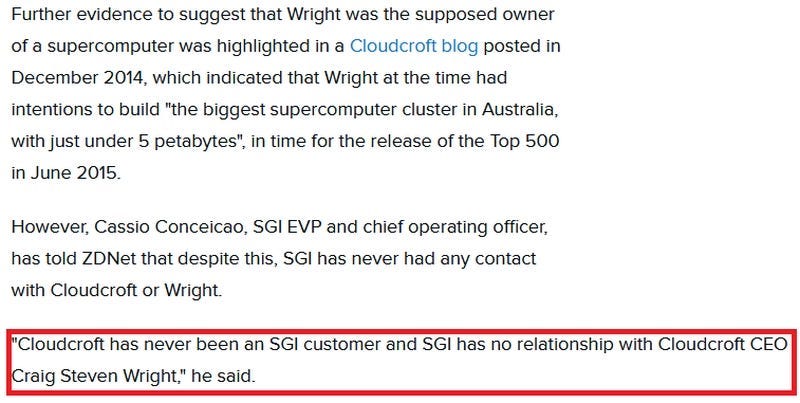 Source: ZDNet
Source: ZDNet
So Craig has spent 2014 digging himself deeper and deeper into his Bitcoin supercomputer lies, his faked business transactions and his faked Bitcoin ownership, 2015 will only see things getting far, far, worse for his tangled web and, ultimately has him fleeing Australia after having fooled a credulous billionaire into believing that he is Satoshi.
 Random artwork Windows 3.0 style found on Twitter
Random artwork Windows 3.0 style found on Twitter
March 26, 2015: The SGI letter forgery.
Remember October 2013, when Craig filed the “Sukuriputo Okane” Bitcoin supercomputer project for R&D tax rebates? In March 2015, the ATO is starting to inquire into this ‘multi-million-dollar project’, so Craig quickly forges a fake SGI letter and puts it on the CloudCroft website — another Potemkin-village facade, of course.
If you’ve read the articles in the Early Years series, when it comes to just how inept Craig is at these fakes and forgeries, you surely know what is coming next…
 Source: WayBack Machine
Source: WayBack Machine
March/April 2015: The “Sukuriputo Okane” project starts falling apart.
The ATO, having visited the premises of Craig Wright as part of their in-depth and (still-to-this-day!) ongoing investigation into Craig Wright and his supposed multi-million-dollar business activities find… drum roll please… no evidence that this Bitcoin supercomputer exists at all.
And as a result, the ever-suitable Faketoshi mantra “[Craig Wright] had not provided any evidence” can be found two handfuls of times, in different shapes and forms, in the relevant section of one of the ATO reports. He won’t be holding back on the wildly fabricated R&D claims just yet, though, because at this time Craig has only had the visit, but not the report of their findings yet, findings which are painfully detailed:
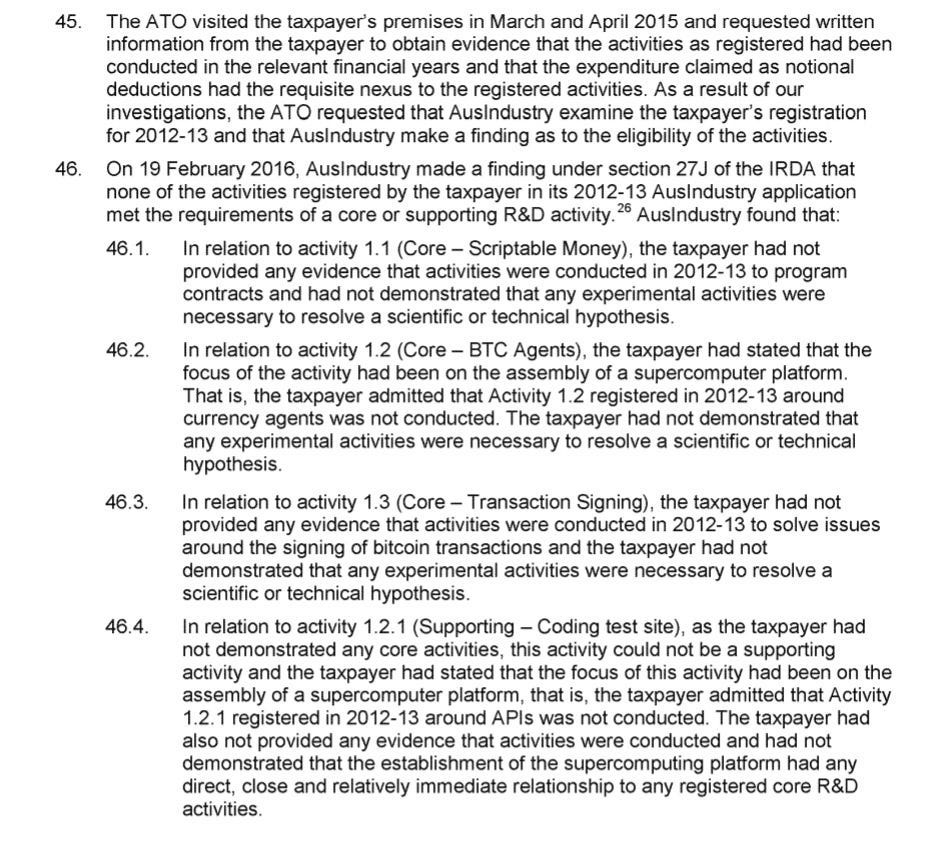 Source: CourtListener
Source: CourtListener
May 11, 2015: DeMorgan $54 million R&D tax rebate announced.
But just when you start thinking, this will be the end of Craig Wright’s false claims, his lies and forgeries are exposed, and he will finally back down with his Bitcoin supercomputers… but no, that’s not how it works with Craig. He will always try to double down, cover up an old lie with a new lie, push old forgeries aside as “the dog ate my homework”, or, to stick with his years long narrative, “I was hacked”.
So Craig wrapped the smoking remains of the bankrupt ‘Hotwire Group’ together under a new label ‘DeMorgan Group’, and tried the same tax fraud again for even larger numbers. It started with a bogus press release without any footing in reality. AusIndustry has no records of this mega claim as far as we know.
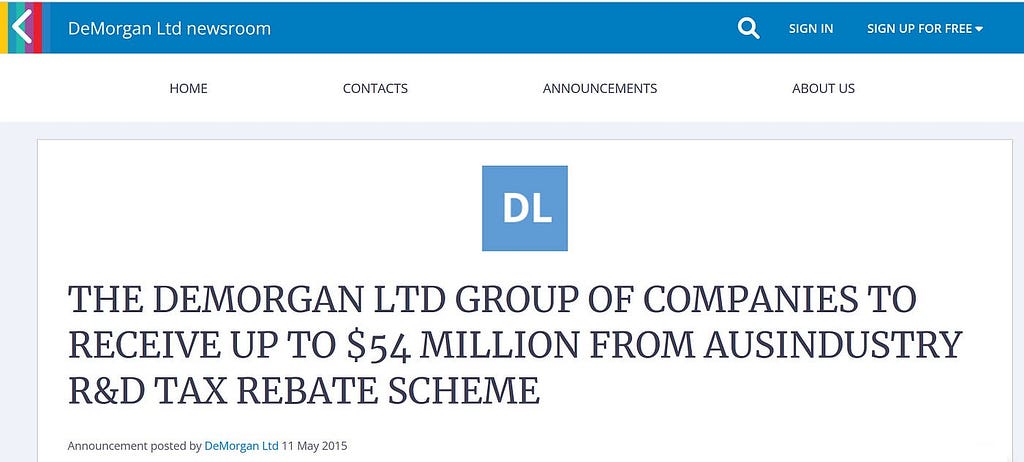 Source: prwire.com.au
Source: prwire.com.au
The full press release — as said pulled from Craig Wright’s ass — reads:
Australia’s fastest Top500 HPC is dedicated to Cryptocurrency and smart contract research
Sydney, NSW, May 11, 2015– DeMorgan Ltd is please to advise that the companies in its controlled group have satisfied the requisite criteria under AusIndustry’s R&D Tax Incentive Scheme for an advance finding with respect to R&D activities conducted in the development of smart contract and Blockchain based technologies.
Under the scheme, companies with a turnover of less than $20 million are entitled to a cash refund of up to 45 cents per dollar spent on eligible research and development activity. Accordingly, DeMorgan Ltd and controlled companies is eligible to receive up to approximately $54,000,000 R&D cash rebate for R&D activities conducted in the 2014/2015 financial year.
CEO Dr Craig Wright said “This rebate will strengthen the group’s cash position and is an important source of funds for our development activities. We acknowledge the Government’s support of important R&D activities, and we look forward to the successful commercialisation of our Blockchain and smart contract systems research.”
The approval of the largest Research and Development Advance Finding and Core Technology reviews in Australian history from AusIndustry for Coin-Exch Pty Ltd, Denariuz Pty Ltd and Cloudcroft Pty Ltd and related companies in our group have allowed us to tune our Supercomputers to an Rmax (Tflop/s): 2,468.15 and 939.67 respectively. We expect that this will place us in the top 20 super computers globally and the fastest computer managed in the southern hemisphere accelerating Australia into a position that is well above its weight. This will result in increased technology development in Australia and help lead our country into a global leadership position.
Our CEO, Dr Wright is excited that this will allow us to start accelerating crypto currency and smart contract and property research to new levels in the southern hemisphere and to create opportunities in Australia that have not been imagined before.
In the coming years, we will be looking to expand our involvement in the region with the creation of a combined CuDA/Xeon Phi hybrid system that we are looking to develop in conjunction with SGI. Success in this endeavor would make Australia a global leader in HPC technology as well as in the emerging crypto-currency financial fields.
Mr McKeon of SGI has stated that they “look forward to a long, sustained relationship” and that together our companies will reach the highest ranks of the Top500 list.
Our company, Interconnected Research Pty Ltd is the only government authorized R&D research provider and accelerator dedicated to fostering crypto-currency specific research with the ability to allow companies to claim up to 43.5 cents in every dollar back as a rebate through the AusIndustry R&D program.
As a way of returning something to the community we are offering a free course on our systems and providing access to one of the world’s fastest HPC systems in conjunction with IT Masters and Charles Sturt University.
DeMorgan is a pre-IPO Australian listed company focused on alternative currency, next generation banking and reputational and educational products with a focus on security and creating a simple user experience. In the six years since the first company in the group started, we have completed several Bitcoin based research projects that have lasted over 6 years and are now ready to start commercialisation.
One week later, the fake press release — again, completely pulled from Craig Wright’s ass — was picked up by media outlet Grant Central, who wrote:
“Adding to the big numbers, DeMorgan Ltd announced in a press release that it had received Australia’s largest R&D Advanced Finding from AusIndustry and would as such be eligible to receive approximately $54,000,000 in R&D cash rebate for the R&D activities conducted in the 2014/15 financial year.” — Grant Central, May 18, 2015
And this is the last time that we hear about R&D tax rebates from Craig Wright. From here onward, the storm that had been brewing since ATO’s Refund Integrity department started their inquiry late 2013 into Craig’s fraudulent tax return claims, events would quickly start to spiral downward for Craig Wright.
Nik Cubrilovic, who, as an Australian citizen, witnessed events from close by, noted on Reddit and on his blog:
“I don’t think the $54 million refund was ever paid, but he was paid earlier $6M and ~$2M refunds — he became more brazen but the last figure was too much even for the ATO (it was a larger claim than what even Google or Atlassian make).
There is also the sales tax case where the ATO found against him and penalized his company, Hotwire, $1.7 million. The way this worked is Wright funded the company with $30 million worth of Bitcoin. The company then purchased software from another Wright entity for $29 million. The first company then made a sales tax refund claim for this purchase and sought ~$3 million as a refund. What Wright was effectively doing was creating $3 million in real-cash refund from the tax office by transferring imaginary Bitcoins between himself. I detail how this worked in my blog post from yesterday.
That entity went from being founded to shutdown in months. The DeMorgan entity seemed to exist solely to make R&D claims from the Australian government.” — Nik Cubrilovic on Reddit
Nik went the extra mile in his inquiry of what happened in this era, and spoke with several eyewitnesses. From his epic blog post of May 2, 2016 called “Craig Wright is not Satoshi Nakamoto” we take the following quote:
“The experience of those who have worked for or know Craig Wright. Sydney is a global city but in many ways it is a small town — I found out after the Wired report that I knew two people who had worked for Wright. Since the stories published today I have come to hear — either directly or second-hand — from a number of other people who either worked for or knew Wright. The conclusion is near-unanimous: Wright is not Satoshi Nakamoto, and is not capable of being Satoshi Nakamoto. One friend described how Wright is so convincing that even tho he knew he wasn’t capable of creating Bitcoin, he would at times even doubt himself. Another said that Wright has everybody convinced for at least a short period — but then it begins to unravel as his actions do not match his word. He came away from his experience convinced that Wright is a fraud. Yet another person who worked for Wright characterized him (via a third-party) as “the best conman i’ve ever met”.” — Nik Cubrilovic
May 29, 2015: Craig tweets about his 2 Bitcoin supercomputers.
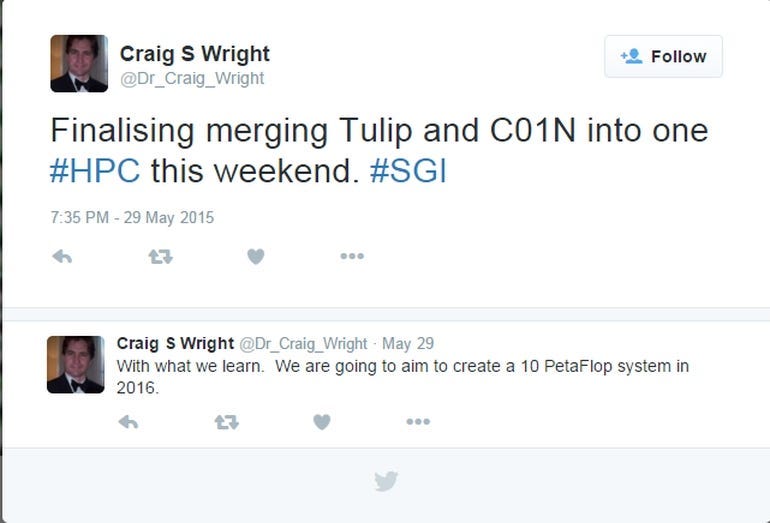
Notice that Craig puts a hashtag with SGI in his tweet, as if SGI had something to do with Craig Wright and the Bitcoin supercomputers mentioned. That remains to be seen, though, as in December 2015 ZDNet figured a few things out about SGI. They wrote about these findings in their article “SGI denies links with alleged bitcoin founder Craig Wright”. A few quotes:
“However, Cassio Conceicao, SGI EVP and chief operating officer, has told ZDNet that despite this, SGI has never had any contact with Cloudcroft or Wright. “Cloudcroft has never been an SGI customer and SGI has no relationship with Cloudcroft CEO Craig Steven Wright,” he said.
Conceicao added that SGI has no record of the C01N supercomputer being purchased or serviced by the firm. The C01N supercomputer, which was placed at number 17 on the list of the world’s fastest supercomputer in November [2015], is another supercomputer that Wright apparently owns. It was allegedly created when Wright merged C01N and Tulip Trading, Cloudcroft’s supposed flagship supercomputer, into a single high performance computer. “SGI has no record of the CO1N supercomputer ever being purchased or serviced from SGI, therefore SGI suspects it may have been purchased on the grey market,” Conceicao said. “SGI does not operate, maintain, or provide any services for this supercomputer.”” — Aimee Chanthadavong (ZDNet)
Note that SGI/Conceicao is implying that Craig Wright ‘could’ have bought an actual supercomputer on the grey market. This, we will learn further down the road, didn’t happen either. But at this moment in time SGI didn’t and couldn’t know better, and they needed to carefully hedge on their statement as they could not explicitly claim (yet) that Craig didn’t have any supercomputer at all.
July 6, 2015: Craig’s final post on the Cloudcroft blog “CEO Update: The Next 5 Years”.
Craig Wright, happy with the lock in of a few million dollars in bail out money from Calvin Ayre and friends in the previous month, money that will lift the ATO burden from his shoulders for a bit, immediately continues with his Bitcoin supercomputer scam. As he writes:
“Despite issues with the ATO, Cloudcroft Supercomputers and its parent group, DeMorgan Ltd, is happy to announce that things are back in full swing as we have secured funding for the next five years to deliver our innovations and solutions to market.”
“Ok, welcome! It’s been a little bit of a break. We’ve been doing our normal battles and all the rest, and well, this week we are coming back to our normal weekly reviews etc. So, an update is more more than anything else rather than talking technology for this particular blog update. The companies are now fully funded — that will go on for at least 5 years (hopefully a lot longer). Details of that, well one day they will come out. What matters for the moment is our ongoing typical battles with Tax office and other such things are all taken care of — others can worry about them other than me.”
Fully funded… mwoah. That remains to be seen.
November 2015: What happened with Tulip Trading’s C01N Bitcoin supercomputer meanwhile?
Referring to the already critical notes made by the ATO found under December 6, 2013 (scroll up a little), we are sure it will come as no surprise to anyone that ATO finally also rejected everything related to this C01N supercomputer.
Look for quotes like:
“Duplicates of serial numbers and UUIDs were observed and the fact that they are also obfuscated, and appear to have been taken from an internet source, makes them unconvincing proof of the existence of the purported C01N supercomputer.”
“The specifications for the purported C01N supercomputer provided by Dr Wright to the ATO are not consistent with each other nor with those listed on the Top500 Website. Again this information appears unreliable.”
“We conclude that the taxpayer did not have access to the purported supercomputer. Given Dr Wright’s extensive IT qualifications, it is inconceivable that he was unaware of this fact.
We therefore conclude the evidence provided to us was manufactured by [Craig Wright] the taxpayer in an attempt to deceive us.”
“Having regard to these inconsistencies and anomalies relating to the contract, the evidence that access to the purported supercomputer was never acquired by [Craig Wright] the taxpayer and the anomalies relating to the purported payment, we do not accept that the evidence provided substantiates that [Craig Wright] the taxpayer incurred expenditure to W&K.
In fact, we infer that these documents were created with the intention of deceiving the Commissioner and in order to support the false and misleading statements of [Craig Wright] the taxpayer.”
 Source: CourtListener
Source: CourtListener
After entering the supercomputer Top500 list in November 2014 on #64 (see also Faketoshi, The Early Years — Part 2), then in June 2015 the Tulip Trading/C01N system was ranked #15, while in November 2015 it was ranked #17 on the Top500 website. However, most these ‘ranks’ can only be looked up with help of WayBack Machine, as the Top500 website has deleted almost all Craig Wright related supercomputer entries from their website.
Computerworld Netherlands explains on June 20, 2016:
“One much-publicized computer you won’t find in the Top500 rankings any more is Tulip Trading’s C01N. Allegedly built by self-styled bitcoin inventor Craig Wright, C01N [Note that this entry is still, confusing many, visible on the top500 website] entered the rankings in 64th place in November 2014, jumping to 15th place in June 2015 following a claimed upgrade.
“When doubts about this system surfaced, we tried to independently verify its existence, but ultimately could not,” Top500 list maintainer Erich Strohmaier said via email.
C01N initially made it into the November 2015 ranking, in 17th place.
“We meant to remove it at that time, but it fell through the cracks for a while. It should get removed from all lists, but older lists get much less attention (and care) than the newest,” Strohmaier wrote. C01N was removed from the November 2015 rankings some time in May [2016], cached copies of the list show, with machines below it all moving up a rank.”
And Craig Wright? He still pretends a nose bleed when asked about the supercomputers in April 2019, and at the same time he conveniently forgets about the Sukuriputo Okane Bitcoin supercomputer that also failed to get approval from the ATO, as it didn’t exist either…
“Q: When did you have a supercomputer?
A: Back in 2013. Sorry, end of 2012, but it was not working. 2013, 2014, 2015.
Q: What was it called?
A: Tulip and C01N. There were two.
Q: So, you did have a supercomputer called C01N?
A: That is what I just said.
Q: When did you get rid of these supercomputers?
A: I did not.
Q: You still have them?
A: I do not have them.
Q: Who has them?
A: I do not know.
Q: What happened to them at the end of 2015?
A: I do not know.” — Vel Freedman, Craig Wright (deposition April 4, 2019)
November 2, 2015: Craig Wright is being ignored on Twitter.
Craig’s Twitter account before he used “ProfFaustus” as his handle was “Dr_Craig_Wright”. Here seen in a hilarious, desperate attempt to reach out to Adam Back, CEO of Blockstream (a well known Bitcoin infrastructure company), and mentioned by Satoshi Nakamoto in the Bitcoin whitepaper in the ‘References’ section with his paper “Hashcash — a denial of service counter-measure”, dated 2002, as inspiration for the mere existence of Bitcoin. Also tagged are Nick Szabo and Gavin Andresen.
Adam Back, however, largely ignored Craig Wright’s repeated attempts to draw him into responding to these tweets as, according to later recollection, he’d already dismissed Craig due to the persistently incoherent nonsense Craig had previously spouted about Bitcoin-related subjects in other discussion threads.
You can see how Craig Wright is boasting about the claimed performance of a supercomputer which was ultimately proven to not even exist. Clearly, he still wants to try and show the ATO, and his gullible new investor bailing him out for $15,000,000 (USD), that he is a respected peer within the Bitcoin intelligentsia. Someone who might, indeed, be Satoshi.
He was, and is, neither.
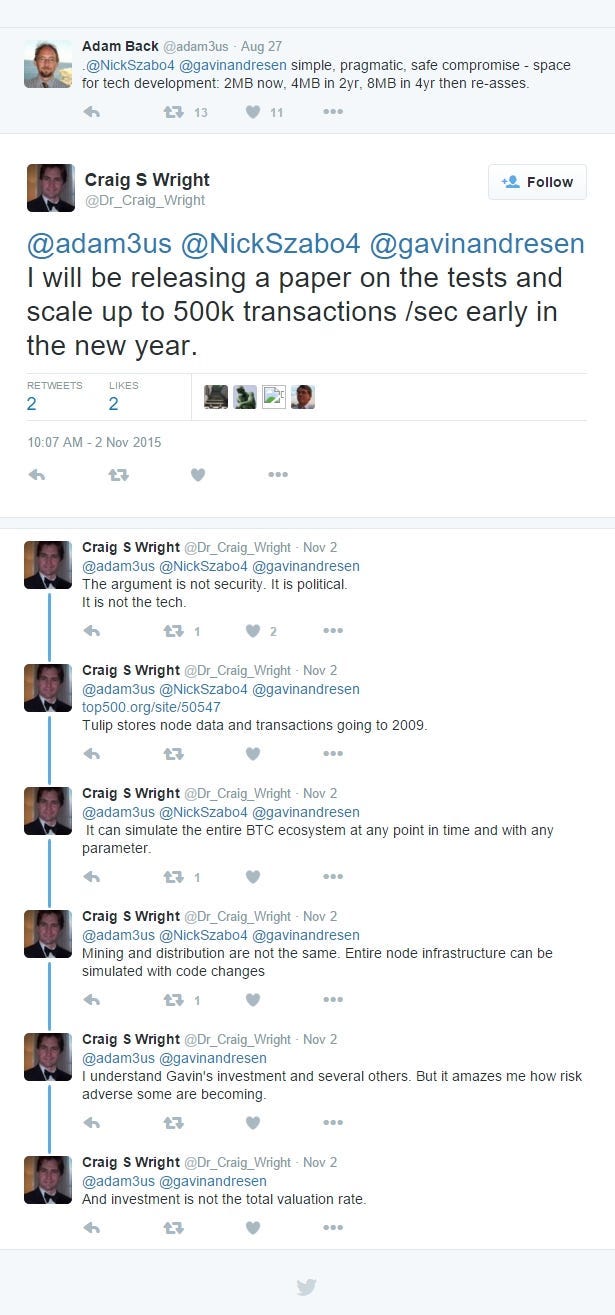
November 19, 2015: Patrick Paige contacts Craig Wright about “a reporter”.
It appears that reporters are starting to inquire about the dox package. But this email from Patrick Paige (Dave Kleiman’s training officer in the army, with who he later started Computer Forensics LLC) is interesting for another tidbit also: Craig claims that Dave Kleiman helped him set up the first supercomputer. You know, that NONEXISTENT supercomputer.

November 29/30, 2015: Craig Wright makes a video appearance on an All-Star Panel of Bitcoin OGs (to a perplexed audience).
https://medium.com/media/3ddc0e260fb10a2876a77c4ac952960a/href
In this video, at 00:33:20 we can hear Craig Wright waffling about doing ‘computing’ in Iceland, on his (NONEXISTENT, remember?) Bitcoin supercomputer called ‘Tulip’ before launching into a tedious tale about the history of Tulips and the associated ‘Tulip Bubble’ which he asserts was a ‘swaption not a bubble’, before finally claiming at 00:35:35 that the ‘computing’ in Iceland, on his (NONEXISTENT, remember?) Bitcoin supercomputer called ‘Tulip’, is all about Bitcoin ‘scalability’. Craig even goes as far as to shamelessly mentioning that his (NONEXISTENT, remember?) Bitcoin supercomputer was “№15 in the top 500 supercomputers globally.”
Now let this sink in for a moment. Craig Wright doesn’t have a Bitcoin supercomputer, but is there on a fifteen-foot video screen, talking over Skype about all the Bitcoin-related work he is doing, in Iceland, on a Bitcoin supercomputer that only existed in his dreams… and on forged invoices paid with nonexistent Bitcoin to advance a multi-million tax scam in Australia.
A nonexistent Bitcoin supercomputer, by the way, which was only called ‘Tulip Trading’ because that was simply the name of the ready-made ‘shelf company’ Craig bought from the Seychelles formation agent previously, that he claimed to the ATO acts as a Trust for a vast wealth in equally-NONEXISTENT bitcoins, you know, for his blatant multi-million-dollar tax fraud their investigators keep exposing!
In any event, this attempted introduction of Craig Wright to the wider Bitcoin community can only be marked as being a total dud. He failed to capture anyone’s interest and merely ended up providing some amusement to Nick Szabo part-way through with a stubborn and willfully erroneous insistence that Bitcoin is ‘Turing complete’.
December 8 & 9, 2015: Wired/Gizmodo reveals & ATO raids
Wired, who published their article first on December 8, 2015 4:25 PM and who had not done much due diligence at this point in time yet, writes about the Bitcoin supercomputers. Wired had no idea that almost all of the things mentioned in this paragraph are lies. There was not “more than $1 million in computers, power, and connectivity”, there was no “fiberoptic cables to his remote rural home in eastern Australia”, and there was no “world’s most powerful privately owned supercomputer”.
“Wright’s blogging and leaked emails describe a man so committed to an unproven cryptocurrency idea that he mortgaged three properties and invested more than $1 million in computers, power, and connectivity — even going so far as to lay fiberoptic cables to his remote rural home in eastern Australia to mine the first bitcoins. His company, Tulip Trading, claims to have built two supercomputers that have officially ranked among the top 500 in the world, both seemingly related to his cryptocurrency projects. (Wright seems to enjoy tulip references, a likely taunt at those who have compared bitcoin to the Netherlands’ 17th century “tulip bubble.”) The first of those supercomputers he named Sukuriputo Okane — Japanese for “script money.” Wright claims another, named Co1n, holds the title of the world’s most powerful privately owned supercomputer. As Wright told the Bitcoin Investor’s conference, he’s applying that second machine towards the mysterious task of “modeling Bitcoin’s scalability,” and meanwhile building an even more powerful supercomputing cluster in Iceland because of its cheap geothermal power.”
The same story goes for Gizmodo, who published their article on December 9, 2015 at 9:30 AM. They briefly mentioned a supercomputer, but had no idea that Craig Wright never had one in real life.
“Last year, Wright publicly announced his plan to establish the “world’s first Bitcoin bank.” Wright’s LinkedIn page lists him as the CEO of DeMorgan Ltd, a company whose website describes it as “focused on alternative currency, next generation banking and reputational and educational products with a focus on security and creating a simple user experience.” Among DeMorgan’s subsidiaries, also listed on its website, are C01n, a Bitcoin wallet company; Coin-Exch, a Bitcoin exchange; and Denariuz, the aforementioned Bitcoin bank, and one of the top supercomputers in the world.”
And then came the raids on Craig’s offices and house. It’s not the subject of this article, but the following quotes give an idea how that went in December 2015.
“Ten men raided a house in Gordon, a north shore suburb of Sydney, at 1.30 p.m. on Wednesday, 9 December 2015. Some of the federal agents wore shirts that said ‘Computer Forensics’; one carried a search warrant issued under the Australian Crimes Act 1914. They were looking for a man named Craig Steven Wright, who lived with his wife, Ramona, at 43 St Johns Avenue. The warrant was issued at the behest of the Australian Taxation Office.”
“Meanwhile, Wright was still standing beside the swimming pool in his suit, with a laptop in his arms. He heard people coming up the stairs, sped down the corridor and ducked into the gents. A bunch of teenagers were standing around but seemed not to notice him. He went to the furthest cubicle and deliberately kept the door unlocked. (He figured the police would just look for an engaged sign.) He was standing on top of the toilet when he heard the officers come in. They asked the youngsters what they were doing, but they said ‘nothing’ and the police left. Wright stayed in the cubicle for a few minutes, then went out and used his apartment keycard to hide in the service stairwell. Eventually, a call came from Ramona on her friend’s phone. She was slightly horrified to discover he was still in the building and told him again to get out. He, too, had a rental car, and had the key in his pocket. He went down sixty flights of stairs to the car park in the basement, unlocked his car and opened the boot, where he lifted out the spare wheel and put his laptop in the wheel cavity. He drove towards the Harbour Bridge and got lost in the traffic.” — The Satoshi Affair
Epilogue
After December 2015, we didn’t hear anything from Craig Wright’s Bitcoin supercomputers anymore. As Craig explained in April 2019 to lawyer Vel Freedman:
“Q: When did you get rid of these supercomputers?
A: I did not.
Q: You still have them?
A: I do not have them.
Q: Who has them?
A: I do not know.
Q: What happened to them at the end of 2015?
A: I do not know.”
What we can conclude is that Craig Wright’s claim of five Bitcoin supercomputers in November 2014 on Quora, whether fake or not, wasn’t supported by the facts either. A lie within a lie. Well done, Craig.
With that said, we are going to close this article with a hilarious burn of nChain CEO Stefan Matthews, who recently announced on Twitter that BSV is going to test 2,000,000 transactions per second in January 2024, after having heard from “the team” about 1,562,000 transactions per second sustained for 2 weeks.
*WuCoin* then offers him a Faketoshi flashback to 2015.
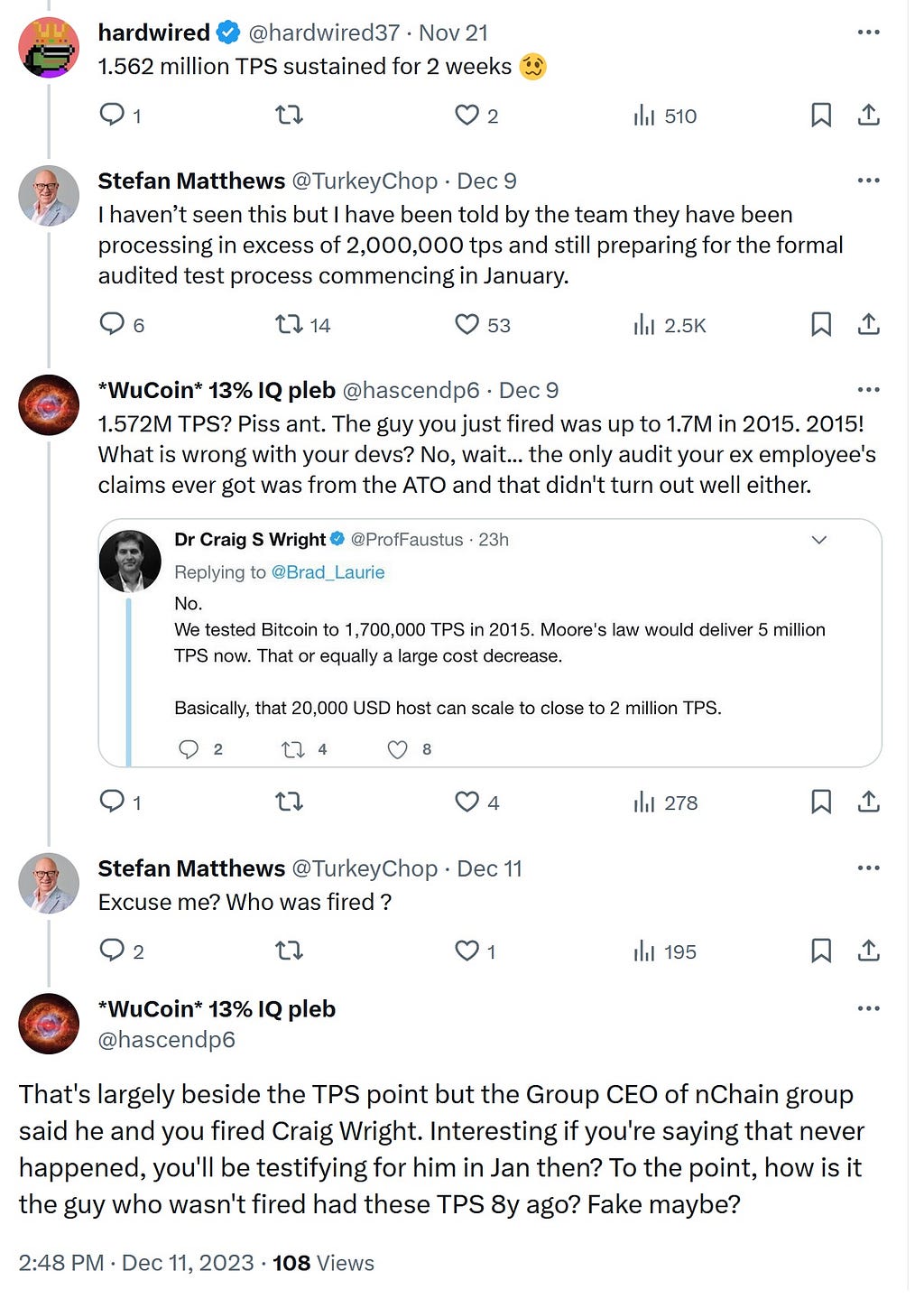 Source: Twitter
Source: Twitter
Thanks for reading, see you next time!
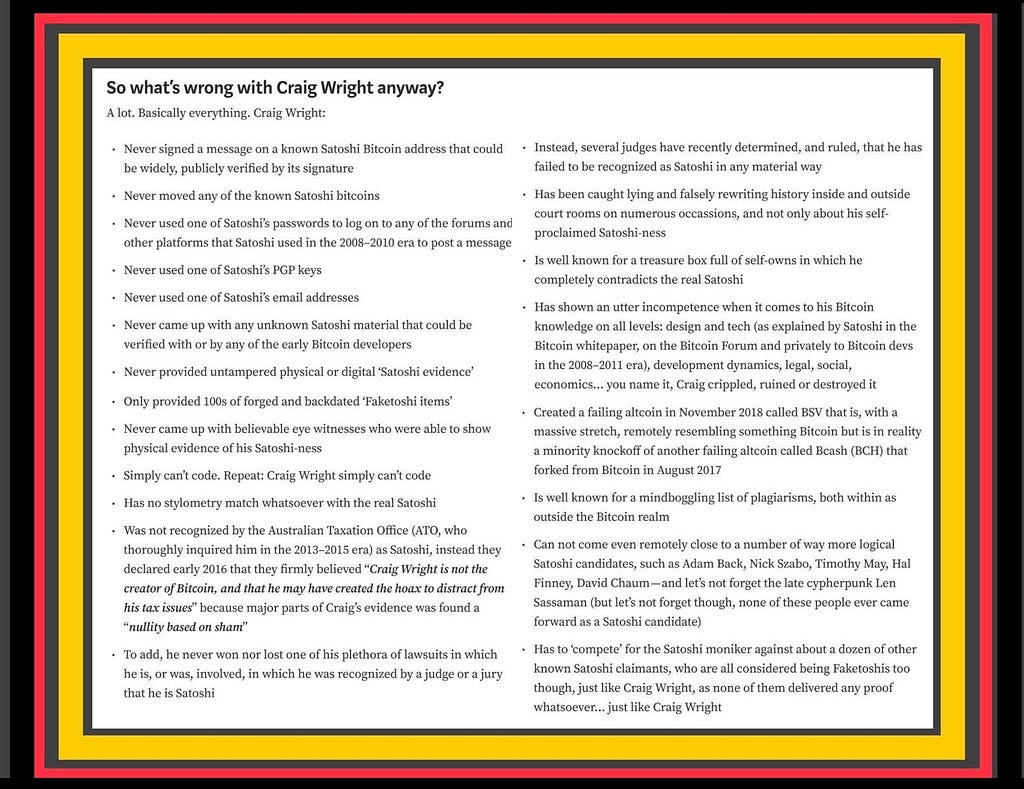 Source: Twitter (Tim Tayshun)
Source: Twitter (Tim Tayshun)
Another History of Craig Wright Fraud And Deception: The Bitcoin Supercomputer Saga was originally published in Coinmonks on Medium, where people are continuing the conversation by highlighting and responding to this story.






